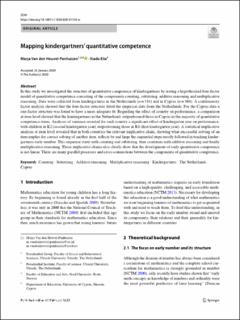| dc.contributor.author | Van den Heuvel-Panhuizen, Marja | |
| dc.contributor.author | Elia, Iliada | |
| dc.date.accessioned | 2020-07-17T12:42:19Z | |
| dc.date.available | 2020-07-17T12:42:19Z | |
| dc.date.created | 2020-05-10T13:40:08Z | |
| dc.date.issued | 2020 | |
| dc.identifier.citation | Van den Heuvel-Panhuizen, M. & Elia, I. (2020). Mapping kindergartners’ quantitative competence. Zdm-Mathematics Education. doi: | en_US |
| dc.identifier.issn | 1863-9704 | |
| dc.identifier.uri | https://hdl.handle.net/11250/2669422 | |
| dc.description.abstract | In this study we investigated the structure of quantitative competence of kindergartners by testing a hypothesized four-factor model of quantitative competence consisting of the components counting, subitizing, additive reasoning and multiplicative reasoning. Data were collected from kindergartners in the Netherlands (n = 334) and in Cyprus (n = 304). A confirmatory factor analysis showed that the four-factor structure fitted the empirical data from the Netherlands. For the Cyprus data a one-factor structure was found to have a more adequate fit. Regarding the effect of country on performance, a comparison at item level showed that the kindergartners in the Netherlands outperformed those in Cyprus in the majority of quantitative competence items. Analyses of variance revealed for each country a significant effect of kindergarten year on performance, with children in K2 (second kindergarten year) outperforming those in K1 (first kindergarten year). A statistical implicative analysis at item level revealed that in both countries the relevant implicative chain, showing what successful solving of an item implies for correct solving of another item, reflects by and large the sequential steps mostly followed in teaching kindergartners early number. This sequence starts with counting and subitizing, then continues with additive reasoning and finally multiplicative reasoning. These implicative chains also clearly show that the development of early quantitative competence is not linear. There are many parallel processes and cross-connections between the components of quantitative competence. | en_US |
| dc.language.iso | eng | en_US |
| dc.publisher | Springer | en_US |
| dc.rights | Navngivelse 4.0 Internasjonal | * |
| dc.rights.uri | http://creativecommons.org/licenses/by/4.0/deed.no | * |
| dc.title | Mapping kindergartners’ quantitative competence | en_US |
| dc.type | Peer reviewed | en_US |
| dc.type | Journal article | en_US |
| dc.description.version | publishedVersion | en_US |
| dc.rights.holder | © 2020 The Author(s) | en_US |
| dc.subject.nsi | VDP::Matematikk og Naturvitenskap: 400::Matematikk: 410 | en_US |
| dc.subject.nsi | VDP::Samfunnsvitenskap: 200::Pedagogiske fag: 280 | en_US |
| dc.source.pagenumber | 15 | en_US |
| dc.source.journal | ZDM: Mathematics Education | en_US |
| dc.identifier.doi | 10.1007/s11858-020-01138-w | |
| dc.identifier.cristin | 1810141 | |
| dc.description.localcode | Paid Open Access | en_US |

